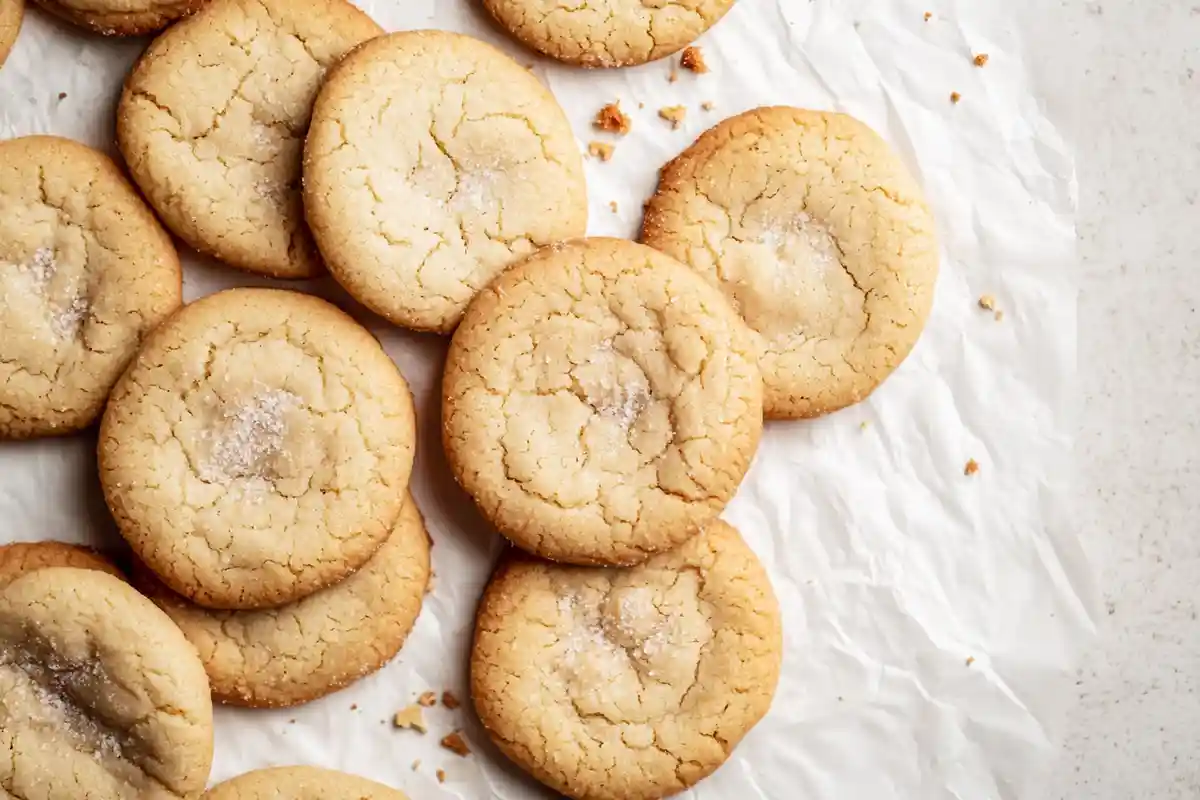Sugar cookies have long been a beloved treat for their simplicity, versatility, and nostalgic charm. Whether enjoyed plain, dusted with sugar, or elaborately decorated for festive occasions, these cookies have earned their place in kitchens worldwide. But what if we told you there’s a way to simultaneously give this timeless classic a subtle tangy twist and reduce food waste? Enter: sourdough discard sugar cookies.
This article will guide you through everything you need to know about making these irresistible cookies. From understanding the role of sourdough discard to mastering the science of baking and troubleshooting common pitfalls, you’ll discover how to create soft, chewy cookies with a flavor profile that’s just a little extra special. So, let’s dive into the world of sourdough discard sugar cookies and see what makes them such a delightful addition to your baking repertoire.
If you love exploring unique and creative recipes like these sourdough discard sugar cookies, don’t miss out on some of our other delightful creations. Try our classic sourdough bread recipe for a tangy and crusty loaf, or explore our soft and chewy chocolate chip cookies for a timeless treat. Looking for something savory? Check out our quick sourdough discard crackers or homemade sourdough pizza dough for your next pizza night
Table of Contents
Introduction to Sourdough Discard Sugar Cookies
The Irresistible Charm of Sugar Cookies
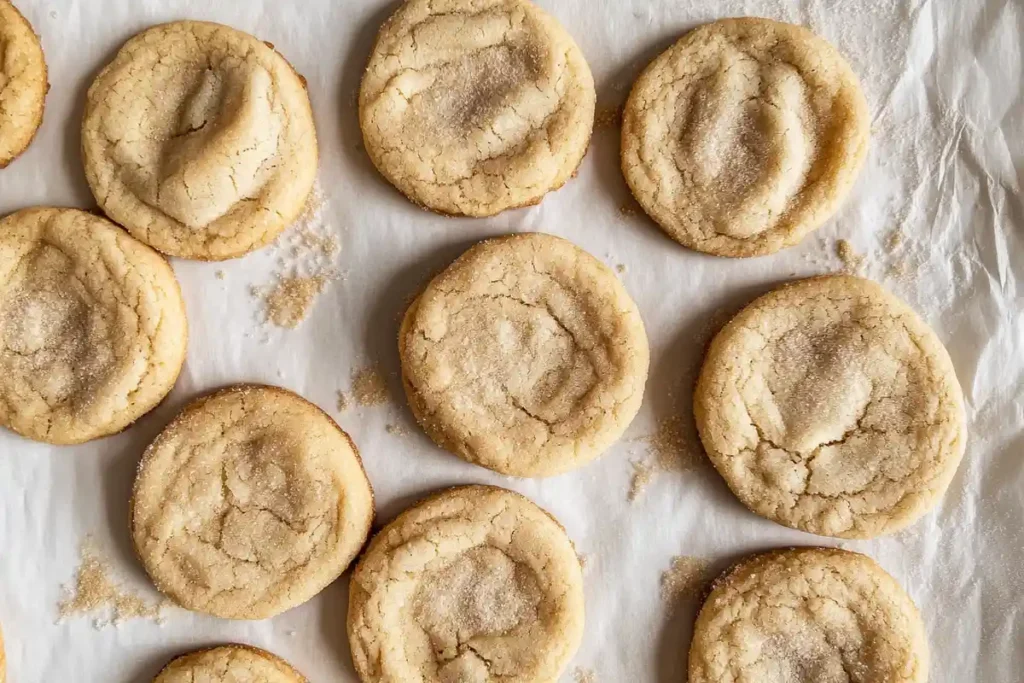
Sugar cookies are more than just a sweet treat; they’re a blank canvas for creativity. From simple rounds sprinkled with sugar to intricate shapes decorated with colorful icing, these cookies have the power to bring smiles to faces of all ages. And let’s face it—nothing beats the smell of freshly baked sugar cookies wafting through the kitchen.
A Brief History of Sugar Cookies
Originating in 18th-century Europe, sugar cookies were initially known as “Nazareth Cookies.” Brought to America by German settlers, these treats quickly became popular for their crisp edges, buttery centers, and ability to hold their shape during baking. Over time, they’ve evolved into the iconic cookies we know and love today.
Why Sugar Cookies Are a Timeless Favorite
Why do we keep coming back to sugar cookies? Perhaps it’s their versatility—they can be soft and chewy or thin and crispy. Or maybe it’s how they pair perfectly with milk and coffee. Whatever the reason, sugar cookies hold a special place in our hearts (and stomachs).
The Perfect Cookie for Every Occasion
Sugar cookies are universal crowd-pleasers. They can be dressed up for weddings, birthdays, and holidays, or enjoyed as an everyday snack. Their adaptability makes them the ultimate cookie recipe for novice and experienced bakers.
From Holidays to Everyday Treats
Holiday baking wouldn’t be complete without sugar cookies shaped like snowflakes, hearts, or pumpkins. But they’re not just for celebrations—they’re equally perfect for a cozy Sunday afternoon or a quick dessert fix after dinner.
Customizing Sugar Cookies for Any Celebration
One of the greatest things about sugar cookies is their ability to be customized. Want them extra chewy? Add more brown sugar. Prefer a crisp bite? Roll them thinner. Need gluten-free? There’s a recipe for that, too!
Elevating Traditional Recipes with Unique Ingredients
Sugar cookies provide the perfect foundation for creativity if you love experimenting in the kitchen. They welcome new flavors and textures without losing their classic charm.
Exploring Innovative Twists
Vanilla and almond extracts are classic flavor enhancers, but why stop there? Citrus zest, spices like cardamom, or even herbs like rosemary can add surprising depth to these otherwise simple cookies.
The Role of Specialty Flours and Star Ingredients
Alternative flours like almond or oat flour can create delightful variations in texture. And when it comes to standout ingredients, sourdough discard is about to steal the show.
The Science Behind Baking with Sourdough Discard Sugar Cookies
Chemical Reactions in Sourdough Discard Sugar Cookies
Baking isn’t just about mixing ingredients and hoping for the best—it’s a fascinating science, especially when sourdough discard enters the equation. The discard isn’t just a leftover starter; it’s a living culture of wild yeast and lactic acid bacteria that interacts with the other ingredients in magical ways.
Role of Natural Yeasts and Bacteria
The wild yeast and bacteria in sourdough discard are still active, even if they’ve been sitting idle in your fridge for a while. When added to sugar cookie dough, these microbes subtly ferment the dough, breaking down starches and proteins. This fermentation doesn’t just affect flavor—it also creates a slightly lighter, airier texture in the final bake.
Impact on Dough Fermentation
Unlike bread dough, sugar cookie dough doesn’t rely on yeast to rise. However, the acids produced by the bacteria in sourdough discard help soften gluten strands, leading to a tender and chewy cookie. Plus, the slight acidity balances out the sweetness of the sugar, giving the cookies a more nuanced flavor.
Texture and Flavor Profiles
The addition of sourdough discard doesn’t just tweak the chemical makeup of the dough—it directly influences both texture and taste.
Achieving the Perfect Chewiness
Who doesn’t love biting into a soft, chewy cookie? The proteins in sourdough discard interact with flour and eggs, helping to create a delightful chew. If you’re after cookies with a crisp edge and a soft center, sourdough discard can be your secret weapon.
Balancing Sweetness and Tanginess
Sugar cookies are typically about sweetness, but sourdough discard introduces a gentle tang that cuts through the sugar. It’s not overpowering—it’s subtle, like a hint of citrus zest in a cake. This balance of flavors makes these cookies feel sophisticated yet still familiar.
Nutritional Aspects
While sugar cookies aren’t exactly healthy food, adding sourdough discard does offer some slight nutritional perks.
Health Benefits of Sourdough Fermentation
During fermentation, the bacteria in sourdough discard break down phytic acid, a compound that can inhibit nutrient absorption. It means your cookies might have a tiny edge in digestibility compared to traditional sugar cookies.
Compared with Traditional Sugar Cookies
Traditional sugar cookies rely heavily on sugar, butter, and white flour—ingredients that, while delicious, offer little nutrition. With sourdough discard, you’re adding trace minerals and beneficial acids, which, while subtle, still count.
Why Science Matters in Baking with Sourdough Discard
Understanding the science behind baking with sourdough discard isn’t just for food scientists—it’s for anyone who wants to bake better cookies. When you know how ingredients interact, you can predict and control the outcome. Whether adjusting baking times, experimenting with ratios, or chilling the dough for optimal results, a little science goes a long way in perfecting your cookie game.
Step-by-Step Guide to Making Sourdough Discard Sugar Cookies
Baking sourdough discard sugar cookies isn’t just about throwing ingredients into a bowl—it’s about precision, patience, and creativity. In this section, we’ll break down every step of the process to ensure your cookies turn out soft, chewy, and irresistibly delicious.
Ingredients Needed
Before you begin, gather all your ingredients. Having everything pre-measured and ready will make baking smoother and more enjoyable.
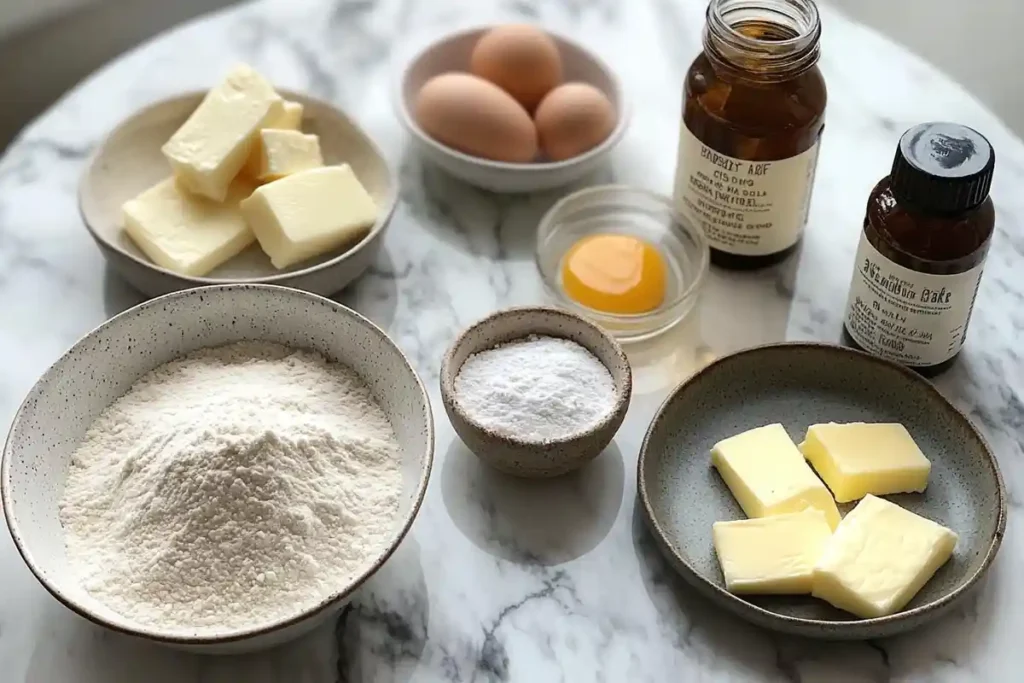
Essential Components
- All-purpose flour: The backbone of any cookie recipe.
- Granulated sugar: Adds sweetness and helps create that classic cookie crunch.
- Brown sugar: Provides moisture and a subtle caramel flavor.
- Butter (unsalted): For richness and a smooth texture.
- Egg: Helps bind the dough and adds structure.
- Vanilla extract: Enhances the flavor profile.
- Sourdough discard: The star ingredient, adds tanginess and softness.
- Baking powder: Ensures the cookies rise slightly and remain tender.
- Salt: Balances the sweetness and enhances other flavors.
Optional Add-ins for Variation
- Chocolate chips
- Citrus zest (lemon or orange)
- Spices like cinnamon or nutmeg
- Nuts (chopped almonds, pecans, or walnuts)
Equipment and Tools
Make sure you have the right tools to simplify your baking process:
- Mixing bowls (one large, one medium)
- Electric mixer or stand mixer
- Whisk
- Measuring cups and spoons
- Cookie scoop or spoon
- Baking sheet
- Parchment paper or silicone baking mat
- Cooling rack
Preparation Steps
Now comes the fun part—mixing, rolling, and baking! Follow these steps carefully for perfect sourdough discard sugar cookies.
Preparing the Sourdough Discard
Ensure your sourdough discard is at room temperature before mixing it into the dough. Cold discard can cause uneven mixing and affect the texture of the final cookies.
Mixing the Dough
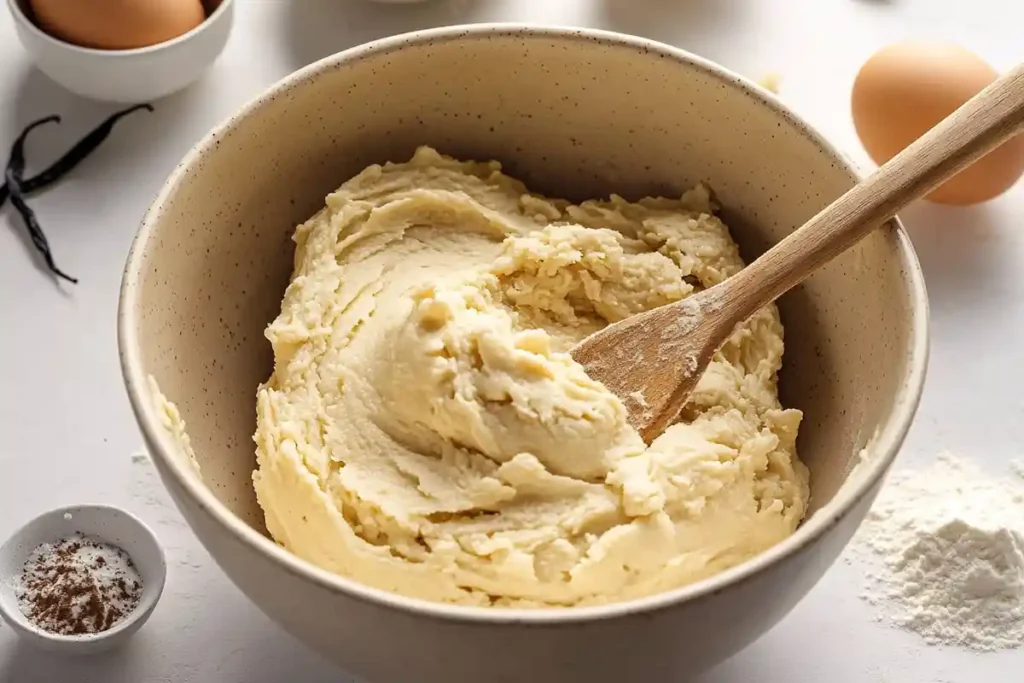
- Cream the Butter and Sugars: In a large bowl, beat the softened butter, granulated sugar, and brown sugar until light and fluffy.
- Add Wet Ingredients: Mix the sourdough discard, egg, and vanilla extract until fully incorporated.
- Combine Dry Ingredients: In another bowl, whisk together flour, baking powder, and salt. Slowly add this dry mixture to the wet ingredients until a soft dough forms.
- Optional Add-ins: Fold in chocolate chips, citrus zest, or nuts if desired.
Shaping and Cutting the Cookies
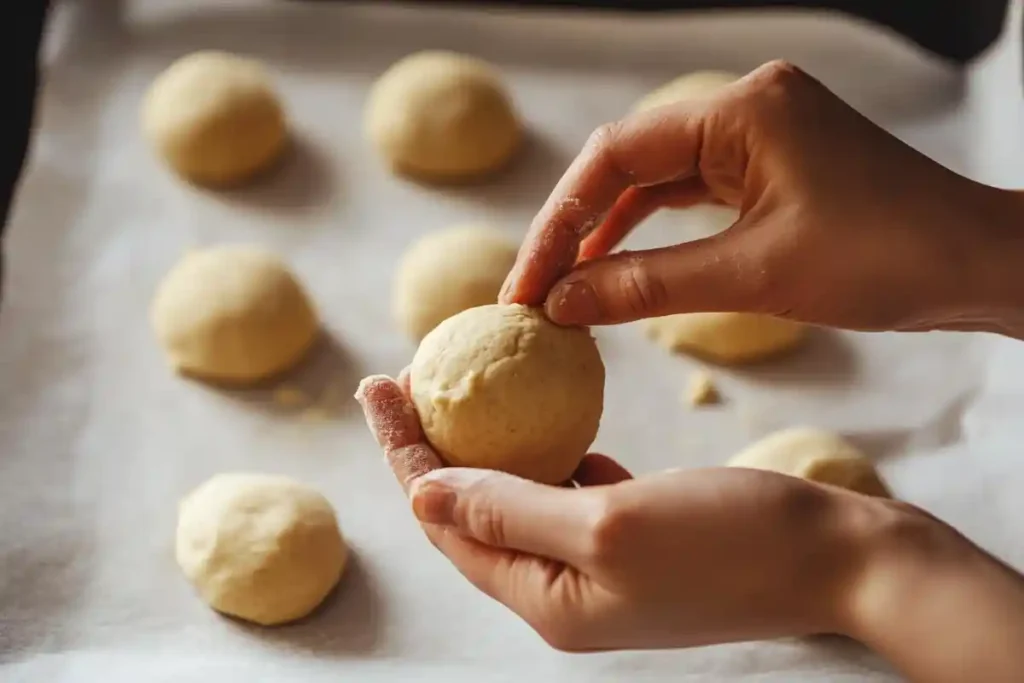
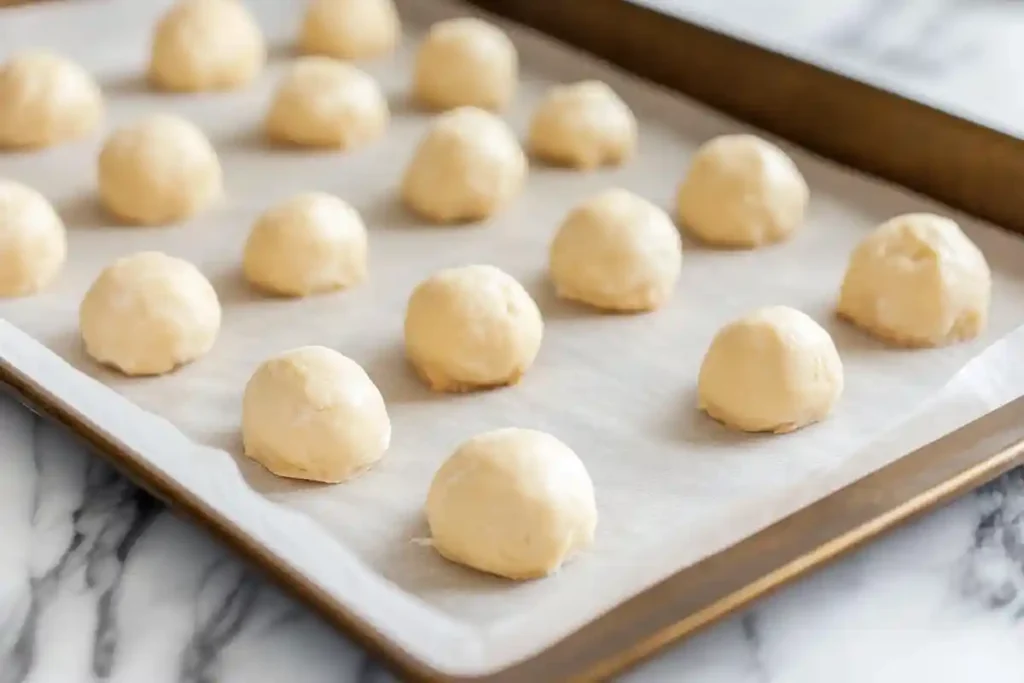
- Pair the dough onto a parchment-lined baking sheet with a cookie scoop or spoon.
- For uniform cookies, lightly press down on each dough ball with the back of a spoon.
- Leave at least 2 inches between each cookie to prevent spreading during baking.
Baking Instructions
- Preheat your oven to 350°F (175°C).
- Place the baking sheet in the middle rack of the oven.
- Bake for 10–12 minutes until the edges turn golden brown.
- Remove from the oven and let the cookies cool on the baking sheet for 5 minutes before transferring them to a cooling rack.
Decorating Ideas
Once your cookies have cooled completely, it’s time to add a personal touch.
Icing and Toppings
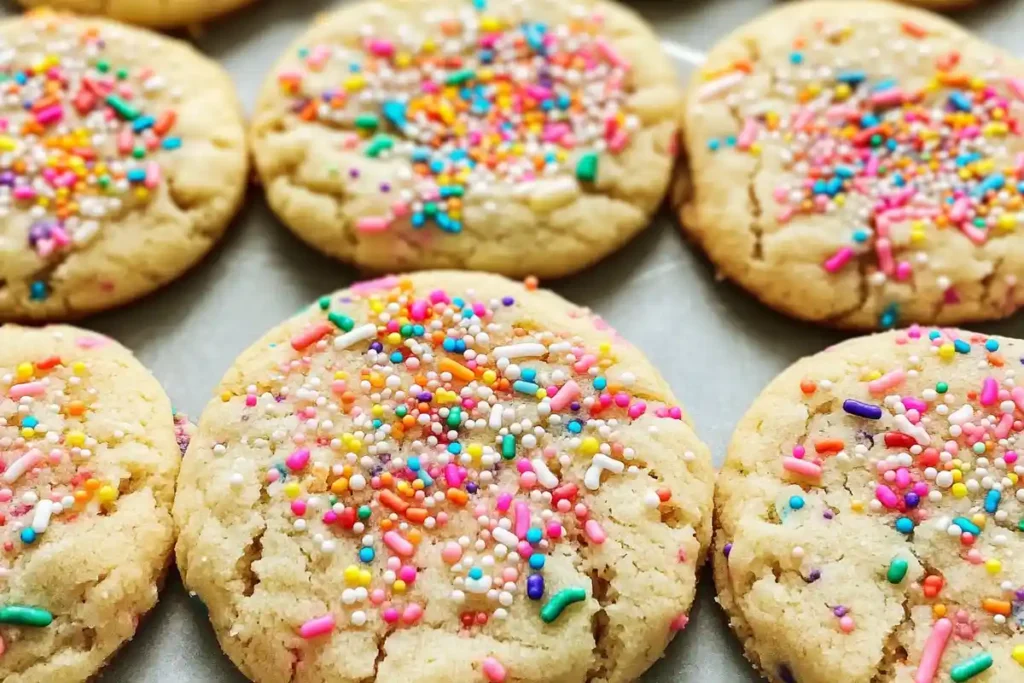
- Drizzle with a simple powdered sugar glaze.
- Sprinkle with colorful sugar crystals or edible glitter.
- Add melted chocolate for an extra layer of indulgence.
Themed Decorations for Special Occasions
- Use cookie cutters to create fun shapes for holidays.
- Decorate with royal icing for a polished look.
- Add edible flowers or gold leaf for an elegant finish.
Baker’s Tips for Success
- Chill your dough for at least 30 minutes before baking if you want thicker, chewier cookies.
- Don’t overmix the dough once the flour is added—it can make your cookies tough.
- Always bake a test batch first to fine-tune the baking time and temperature.
Troubleshooting Common Issues in Sourdough Discard Sugar Cookies
Baking sourdough discard sugar cookies can feel like an art and a science. Sometimes, despite your best efforts, things don’t turn out right. Don’t worry—we’ve all been there. In this section, we’ll address the most common problems bakers face and offer practical solutions to ensure your cookies are soft, chewy, and perfectly golden every single time.
Why Did My Sugar Cookies Get Hard?
Ah, the heartbreak of biting into what should be a soft cookie, only to find it’s as hard as a hockey puck.
Overbaking Concerns
Overbaking is the most common culprit behind hard cookies. Even a minute too long in the oven can dry them out.
- Solution: Always bake your cookies at the recommended temperature and check them a minute before the timer goes off. They should look slightly underdone in the center when you pull them out—they’ll continue cooking on the baking sheet as they cool.
Ingredient Ratios and Their Effects
Too much flour or too little fat can also result in dry, hard cookies.
- Solution: Double-check your measurements and use the spoon-and-level method when measuring flour. Never scoop flour directly from the bag with your measuring cup—it compacts the flour and leads to excess in your dough.
Addressing Spread and Shape Problems
Ever pulled a tray of cookies out of the oven only to see they’ve spread into a giant, unrecognizable blob?
Importance of Dough Chilling
Warm cookie dough tends to spread excessively during baking.
- Solution: Chill your dough for at least 30 minutes before baking. This firms up the butter and prevents the cookies from spreading too much in the oven.
Correct Oven Temperature
An oven that runs too hot or cool can wreak havoc on your cookies.
- Solution: Use an oven thermometer to ensure your oven is at the correct temperature. Baking at a lower temperature can cause the butter to melt before the structure sets, leading to flat cookies.
Flavor and Texture Adjustments
Sometimes the texture is perfect, but the flavor feels a little… off.
Modifying Sweetness Levels
Sugar cookies rely on the perfect balance of sweet and tangy. Too much sugar can overpower the delicate tang from the sourdough discard.
- Solution: Taste your dough before baking (yes, it’s okay in moderation!) and adjust the sugar slightly if needed.
Enhancing Sourdough Tang
If you want a stronger tang from your sourdough discard, there are ways to coax out those flavors.
- Solution: Use older discard sitting in the fridge for a few days. The longer it ferments, the tangier it gets. Ensure it doesn’t smell sour or like alcohol—it should have a pleasant spicy aroma.
Cookies Too Puffy or Too Flat?
Cookie shape can be as important as flavor. Puffy, cakey cookies or paper-thin spread-outs often result from small missteps.
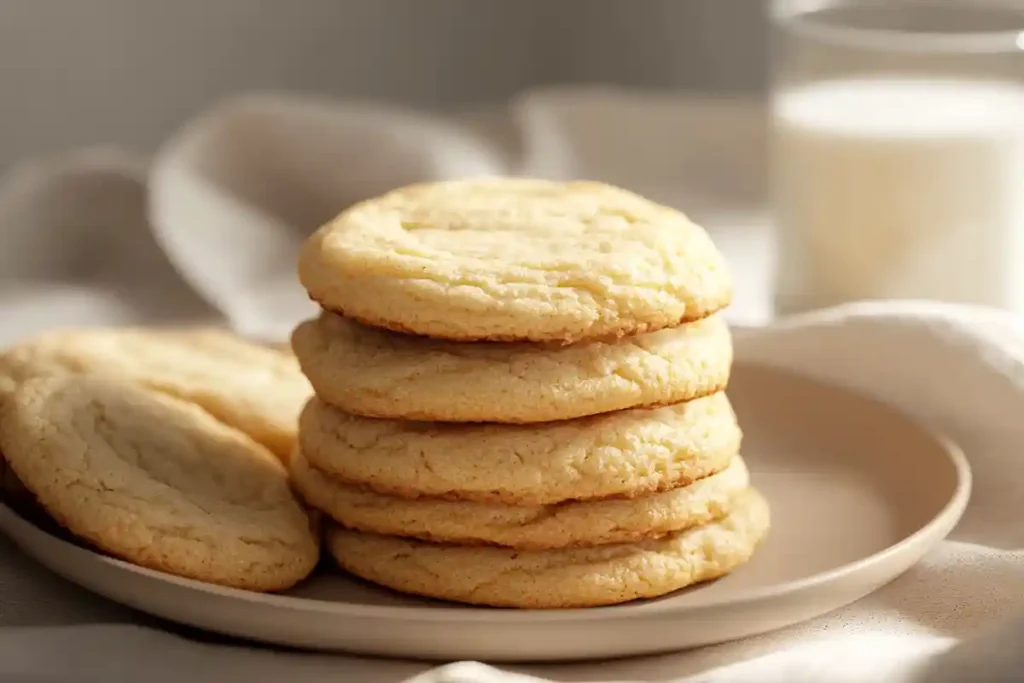
Too Puffy:
- It can happen if too much flour or baking powder is over-measured.
- Solution: Ensure proper flour measurement and double-check your leavening agents.
Too Flat:
- This often means too little flour or overly soft butter.
- Solution: Chill the dough and ensure your butter isn’t melted—just softened.
Baker’s Quick Fix Cheat Sheet
ProblemCauseSolution
Hard Cookies Overbaking Reduce baking time, watch closely
Excessive Spreading Warm dough, hot oven Chill dough, check oven temp
Lack of Tangy Flavor Fresh discard is used Use older discard for tanginess
Too Flat Cookies Soft butter, low flour Chill dough, measure flour properly
When in Doubt, Start Fresh
Sometimes, it’s easier to scrap a bad batch and start over. Baking is a learning process, and each mistake is an opportunity to improve. Take notes, tweak your process, and most importantly—don’t be afraid to experiment!
FAQ’s and Additional Tips for Sourdough Discard Sugar Cookies
Baking sourdough discard sugar cookies combines tradition with a modern twist, but it’s natural to have questions. In this final section, we’ll tackle some of the most common queries and share additional tips to ensure your cookies are perfect.
What Happens If You Bake Sourdough Discard?
Baking with sourdough discard introduces subtle complexity to your cookies. The natural yeasts and bacteria in the discard don’t cause the cookies to rise like bread but add a tangy flavor and softer texture.
- Key Takeaway: Discard contributes flavor and moisture, creating a unique cookie experience.
Why Did My Sugar Cookies Get Hard?
Hard sugar cookies are usually caused by overbaking or using too much flour. Even minor mistakes can make a difference.
- Quick Fix: Watch your baking time closely, measure flour carefully, and ensure your oven temperature is accurate.
What Uses a Lot of Sourdough Discard?
While sugar cookies are a fantastic way to use discard, there are many other creative uses:
- Pancakes and waffles
- Crackers
- Brownies
- Muffins
These recipes often allow for larger amounts of discard and can help you minimize waste in your kitchen.
Is Sourdough Discard the Same as Levain?
No, they are not the same.
- Sourdough discard is the portion of the starter that’s removed before feeding. It’s often considered “inactive” but still contains live cultures.
- Levain, on the other hand, is an active and fed starter used specifically for baking bread.
When baking cookies, discard is your go-to—it’s flavorful but won’t cause excess rising.
Storage and Shelf Life of Sourdough Discard Sugar Cookies
Cookies are meant to be enjoyed fresh, but proper storage ensures they stay tasty longer.
- Store cookies in an airtight container at room temperature for up to 5 days.
- For longer storage, freeze them in a sealed bag for up to 3 months.
- If the cookies lose their softness, pop them in the microwave for 5–10 seconds.
Creative Variations to Try
Once you’ve mastered the basic recipe, it’s time to let your imagination run wild.
Adding Citrus Zest for Extra Flavor
A bit of lemon or orange zest brightens the tangy notes from the sourdough discard and adds a refreshing twist.
Incorporating Chocolate Chips or Nuts
Add chocolate chips, white chocolate chunks, or chopped nuts for an extra layer of texture and flavor.
Spiced Cookies for the Holidays
A dash of cinnamon, nutmeg, or ginger transforms your cookies into a cozy holiday treat.
Baker’s Final Tips for Success
- Use mature discard: Older discard has a tangier flavor, which shines in sugar cookies.
- Chill the dough: Chilling prevents excessive spreading and enhances flavor.
- Experiment: Don’t avoid trying different flavor combinations—baking is all about creativity.
- Test small batches: First, bake one or two cookies to gauge timing and oven behavior.
The Joy of Baking Sourdough Discard Sugar Cookies
There’s something incredibly satisfying about turning leftover sourdough into golden, chewy, flavorful sugar cookies. Whether you’re baking for a holiday gathering, a cozy night in, or simply to avoid food waste, these cookies are a delightful reward for your efforts.
And with these FAQs and tips in your toolkit, you’re well on your way to cookie perfection. So preheat that oven, grab your rolling pin, and enjoy the process—because the best cookies always come from a place of joy.
Now go on, bake with confidence, and let the aroma of sourdough discard sugar cookies fill your kitchen!

